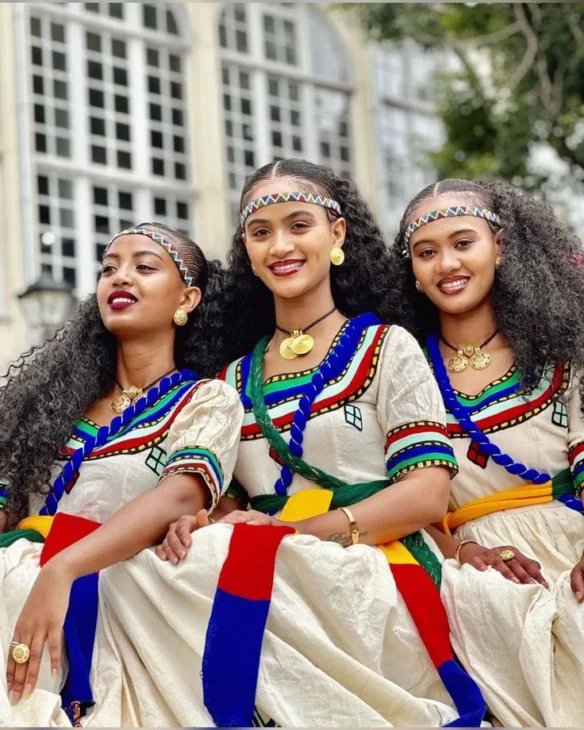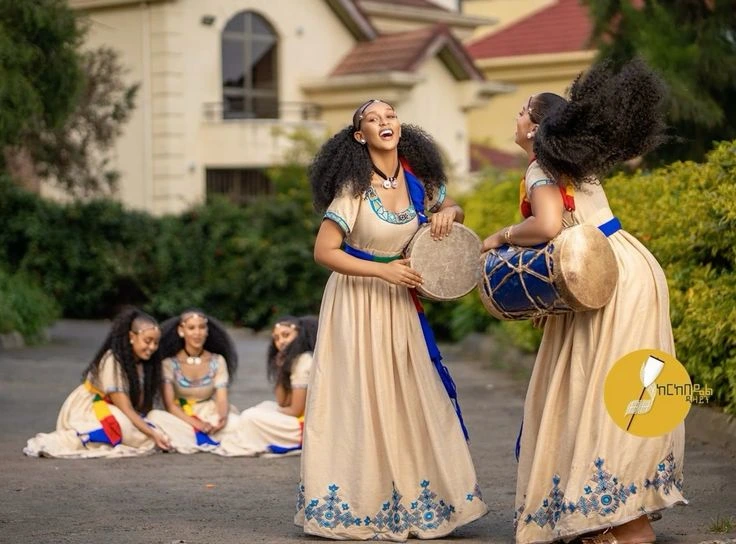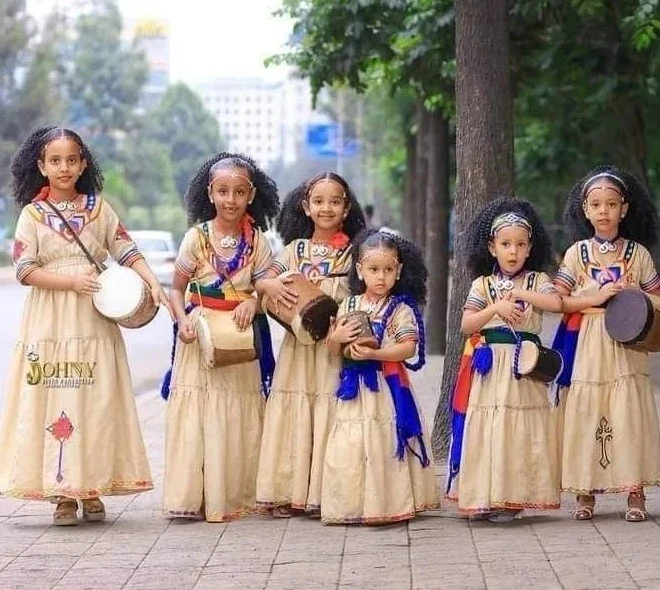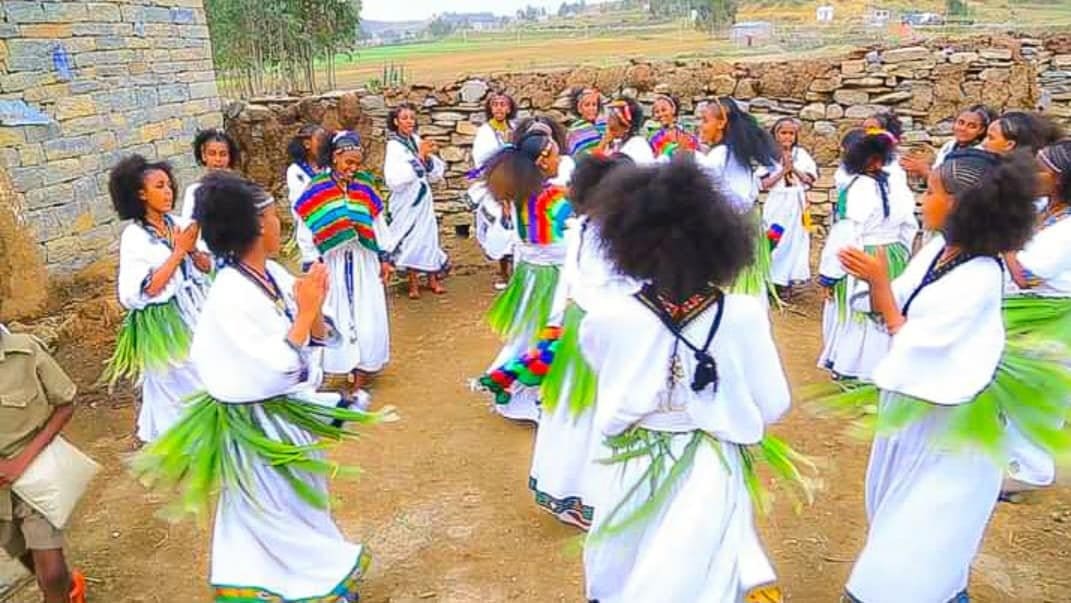Ashenda: Ethiopia’s Festival of Women, Faith, and Freedom

Where Culture, Faith, and Feminine Joy Intertwine
Ethiopia is a land where history breathes through music, colors, and ceremony. Its ancient festivals are not just events on a calendar; they are living expressions of faith, culture, and identity. Yet among all Ethiopian festivals and traditions, Ashenda stands apart. Every August, as the sun warms the highlands of Tigray and Amhara, streets bloom with rhythm, laughter, and vibrant dresses. The air fills with the sound of drums, songs, and joy so infectious that even passersby cannot help but join in.
Ashenda is more than a festival. It is a tribute to womanhood, freedom, and faith, woven together through centuries of devotion and cultural pride. For one week, Ethiopia’s north becomes a canvas of beauty and expression, a space where women lead, faith blossoms, and unity dances in the streets.
The Roots of Ashenda: Where Faith Meets Folklore
To truly understand Ashenda’s meaning, you have to look beyond its music and color to the deep spiritual and historical roots that shaped it. What began as an act of faith centuries ago has grown into a powerful expression of culture and community.
Origins and Historical Background
Ashenda’s origins stretch back centuries, deeply tied to Ethiopia’s spiritual and cultural foundations. The festival coincides with the end of Filseta, a two-week fasting and prayer period in the Ethiopian Orthodox Tewahedo Church dedicated to the Virgin Mary. As Filseta concludes, Ashenda begins, a moment of joy after devotion, celebration after reflection.
What began as a spiritual commemoration of St. Mary evolved into a cultural phenomenon that now defines entire communities. In ancient times, women would gather to sing hymns of gratitude, celebrating both faith and harvest. Over the years, those melodies turned into songs of sisterhood and joy, carried through generations.

In Tigray, an old saying captures the festival’s spirit perfectly:
“ቆልዓ ኣሸንዳ ሪኢኻ ኣይትተሓፀ,”
meaning “Don’t propose to an Ashenda girl.”
Beneath the playful warning lies a deeper message. During Ashenda, women radiate confidence, beauty, and joy, fully embracing their independence and the celebratory freedom of the festival. Every outfit, braid, and accessory is part of a ritual of pride, connecting them to tradition while expressing their own vibrant identity.
The Symbolism of the Name “Ashenda”
The word Ashenda itself comes from Tigrinya, meaning “tall green grass.” This grass, often 80 to 90 centimeters in height, symbolizes life, purity, and renewal. During the festival, young women gather bundles of the grass, tying them at their backs as they dance and sing.
Homes and streets are decorated with fresh grass, believed to bring blessings and abundance. In this simple yet profound act, nature becomes part of the celebration, grounding faith in the rhythms of the earth. Every leaf, every scent of grass, whispers the same message: life is sacred, and celebration is divine.

Growth and Evolution Through the Centuries
Ashenda has blossomed from a local celebration into a national and global emblem of Ethiopian heritage. Once celebrated primarily by Orthodox Christians, it now welcomes participants of all faiths, including Muslim and Protestant communities who embrace the festival’s cultural significance.
In modern times, Ashenda’s songs and dances echo across continents. From Addis Ababa to Washington D.C., from Mekelle to Melbourne, diaspora communities recreate their magic, connecting Ethiopian daughters abroad to the soil of their ancestors.
The Spirit of Ashenda Today: A Celebration of Women and Freedom
While Ashenda’s origins are deeply spiritual, its modern spirit has evolved into something broader, an anthem of womanhood, resilience, and joy. Today, the festival stands as a living celebration of women leading with confidence, creativity, and faith.
Empowerment and Sisterhood in Every Dance
Ashenda is a festival where women reign. For days, young girls and women take over the streets, dancing in groups, singing from house to house, and sharing blessings. Each performance is a tapestry of unity, confidence, and cultural pride.
Their attire is full of symbolism. The Habesha kemis, a white cotton dress adorned with handwoven embroidery, represents grace and purity. A cross drawn on the forehead stands for faith, while a belt of green leaves or grass tied at the waist embodies fertility and renewal. Every bead, braid, and gesture tells a story; one of identity, continuity, and beauty.
And then comes the laughter, the songs, the radiance that fills the air. During Ashenda, women are not just participants; they are the festival itself. Men watch with admiration, clap to the rhythm, and record the dances, but they step back respectfully, giving women the space to lead and shine.

How Social Media Transformed the Festival
In the age of smartphones and global connection, Ashenda has found new life online. Videos of colorfully dressed girls singing traditional songs go viral each year, sparking fascination worldwide. Influencers travel to Mekelle and Axum just to witness the spectacle firsthand.
Social media has amplified what Ethiopia has always known: that Ashenda is a masterpiece of joy and strength. Hashtags like #AshendaFestival and #EthiopianFestivals trend globally, turning the celebration into both a local tradition and a global conversation about culture, womanhood, and pride.
Mekelle Comes Alive: The Pulse of Preparation
As Ashenda draws near, the heart of northern Ethiopia begins to quicken nowhere more vividly than in Mekelle. In the weeks before the festival, the city hums with anticipation, every street and marketplace preparing to welcome a celebration generations in the making.
The Build-Up and the Citywide Excitement
Weeks before Ashenda begins, Mekelle transforms. The anticipation hums in every corner, from the chatter of markets to the hum of hairdryers in Albaso salons. Hairdressers are fully booked, tailors stay up late perfecting each Habesha kemis, and shopkeepers line their stalls with shimmering jewelry, scarves, and accessories.
The streets buzz with life. Music pours from cafés and minibus radios. Even the air feels different; fragrant with incense, excitement, and the scent of new beginnings. Locals call it the season of color, a time when every girl dreams of standing tall, wrapped in tradition and confidence.
Music, Performances, and Street Energy
As the festival opens, drums echo across the city, signaling the start of the celebration. Girls form circles, their voices rising in unison, singing songs that mix humor, praise, and cultural storytelling.
The rhythm is contagious. Streets become dance floors, neighborhoods turn into open-air concerts, and passersby join the chorus. Traditional groups perform on makeshift stages, while pop artists remix Ashenda tunes for a modern twist. In every note and movement, the spirit of Ethiopia thrives; ancient, resilient, and alive.

The Attire: Meaning in Every Detail
In Ashenda, what you wear is more than decoration; it’s storytelling in fabric and thread. Every color, braid, and pattern carries meaning, linking personal expression with ancestral heritage in ways both intimate and profound.
Traditional Clothing and Accessories
Fashion during Ashenda is not just aesthetic; it is heritage in motion. The Habesha kemis, woven with intricate patterns known as tibeb, remains the centerpiece of the celebration. Traditionally, it’s a handspun white cotton dress paired with a netela (shawl) that drapes gracefully across the shoulders. Adorned with silver or gold jewelry, each handcrafted by local artisans, the attire reflects purity, pride, and faith. A small cross on the forehead often completes the look, a symbol of blessing and devotion.
Yet, in recent years, Ashenda’s palette has expanded beyond the familiar white. Many young women now wear vibrant chiffon dresses in blue, orange, green, or pink, their colors shimmering in the sun as they dance through the streets. These modern outfits are coordinated among groups of friends, reflecting unity, style, and youthful energy, a sisterhood stitched together in color.
At the waist, women once tied the Ashenda grass belt, a symbolic link to nature and fertility. Today, the belt has become optional, often replaced by ribbons, floral details, or matching sashes that suit modern aesthetics. This quiet evolution invites reflection: as the festival becomes more expressive and global, could it be slowly shifting from its religious roots and singular cultural symbolism?

Perhaps this transformation is not loss, but renewal. Ashenda’s essence has always been adaptive, balancing faith, femininity, and freedom. Whether wrapped in a traditional Habesha kemis or a flowing chiffon gown, every woman still carries the same message: that her identity, strength, and beauty deserve celebration.
Cultural Sayings and Aesthetic Pride
In Ethiopian culture, beauty is both reverence and respect. Each braid, each embroidered thread, each shimmer of jewelry represents not vanity but devotion, to self, to heritage, and to community.
Every mirror reflection is an echo of the past, a continuation of ancestors who danced in similar attire under the same August sun. Through meticulous adornment, today’s Ashenda girls honor generations before them while redefining what Ethiopian beauty means in the modern world.
Songs, Dance, and the Magic of Sisterhood
Ashenda’s heartbeat is in its music. Groups of girls move from house to house singing, dancing, and blessing families with joyful lyrics. Their songs praise beauty, tease friends, and celebrate life itself. In return, households offer small gifts or tokens of appreciation.
These exchanges foster unity and kindness; they are reminders that joy multiplies when shared. Men and boys clap, cheer, and sometimes film the spectacle, but the spotlight remains on the women. This balance, support without dominance, gives Ashenda its unique harmony of respect and celebration.
Ashenda Beyond Borders: Ethiopia’s Cultural Gift to the World
Ashenda’s spirit doesn’t end when the music fades in Ethiopia’s highlands; it travels wherever Ethiopian hearts reside. Across continents, diaspora communities have carried the festival’s rhythm with them, turning it into a bridge between homeland and heritage.
Diaspora Celebrations and Global Recognition
Across the globe, Ethiopian communities recreate Ashenda in parks, auditoriums, and city squares. In Washington D.C., London, and Toronto, the festival has become a beacon of identity; a way for Ethiopian women abroad to stay connected to their roots.
Cultural organizations and embassies often host Ashenda gatherings, inviting locals to experience the music, dress, and spirit firsthand. UNESCO has taken notice, with efforts to recognize Ashenda as intangible cultural heritage, ensuring its preservation for generations to come.
The Rise of Cultural Tourism
Each year, more travelers plan their trips around Ashenda. Airlines offer seasonal packages, hotels organize themed events, and travel influencers promote “Ashenda season” as Ethiopia’s most colorful time of year.
For tourists, it’s more than a festival; it’s an awakening. Standing amid the songs, watching hundreds of women dancing in harmony, one feels the pulse of Ethiopia itself: proud, ancient, and alive with modern confidence.
Experiencing Ashenda as a Visitor: Respect and Wonder
To witness Ashenda as a visitor is to step into a living celebration of faith, femininity, and freedom. But beyond the vibrant dresses and joyful songs lies a deeper story, one that calls for awareness, respect, and genuine participation.
How to Participate Respectfully
Visitors are warmly welcomed at Ashenda, but respect is the key to meaningful participation.
- Dress modestly, ideally in light traditional attire or neutral colors.
- Ask before photographing dancers or ceremonies.
- Support local artisans by buying traditional clothing or jewelry directly from makers.
- Plan early – flights and hotels in Mekelle, Adigrat, and Axum fill up quickly.
By honoring local customs, travelers become not just observers but part of the living story of Ashenda.
The Heart of Ashenda: Where Joy Meets Faith
As the final songs fade and the crowds begin to disperse, an indescribable warmth lingers. The scent of grass, the echo of drums, and the memory of laughter fill the air. In that moment, it becomes clear that Ashenda is not just a festival; it is the heartbeat of faith and freedom.
It celebrates women who stand tall, rooted in culture yet open to the world. It honors communities that have carried their traditions with grace, resilience, and pride. And it reminds every witness that joy and spirituality can coexist beautifully, that dancing can be a prayer, and color can be a form of devotion.
To experience Ashenda is to see Ethiopia at its most radiant: proud of its past, alive in its present, and dancing toward its future. Ashenda is not just celebrated; it is felt. It is sung, worn, and lived. It is Ethiopia’s gift to the world: a living melody of faith, womanhood, and freedom.
FAQs
When and where is the Ashenda festival celebrated?
Ashenda is celebrated every year in August, following the Feast of the Assumption of the Virgin Mary (Filseta). It takes place mainly in the Tigray and some places in the Amhara regions of northern Ethiopia, especially in cities like Mekelle, Axum, Adigrat, and Lalibela. However, it’s increasingly recognized across the country and by Ethiopian communities abroad. The festival’s dates can vary slightly depending on the Ethiopian Orthodox calendar, but it generally falls between August 16–26.
What should visitors wear to the Ashenda festival?
Visitors are encouraged to wear light, respectful clothing suitable for hot weather and cultural settings. Women can embrace the festive spirit by wearing a Habesha kemis (traditional white cotton dress) or add accessories like netela shawls or colorful headscarves. Men often wear traditional shamma or simple casual attire. Comfortable shoes are essential for walking through lively crowds. Remember that modesty and participation show respect, and blending in with local customs helps you experience Ashenda’s warmth more authentically.
What Are the Best Locations to Experience Ashenda?
The Ashenda Festival is celebrated in various towns across the Tigray and Amhara regions, with Mekelle being the most prominent location. Other notable towns where the festival is celebrated include Adigrat, Aksum, and Lalibela. Each location offers a unique experience, with Mekelle known for its grand celebrations and cultural events. Travelers can choose their destination based on the type of experience they seek, whether it’s a large-scale festival or a more intimate community celebration.
Is Ashenda safe for tourists, and how can travelers engage respectfully?
Yes, Ashenda is considered safe and welcoming for both local and international visitors. The festival embodies community, hospitality, and joy. To engage respectfully:
- Always ask before photographing participants, especially women.
- Support local vendors by buying crafts or food.
- Avoid disruptive behavior during religious songs or prayers.
- Learn a few local greetings like “Melkam Ashenda!” (Happy Ashenda!).
These gestures are appreciated and often spark warm connections with locals.
What is the religious and cultural significance of Ashenda?
Ashenda marks the end of the two-week Filseta fast, honoring the Assumption of the Virgin Mary. It symbolizes purity, womanhood, and renewal. Spiritually, it’s a time for gratitude and communal prayer; culturally, it celebrates female freedom and empowerment. Young women sing, dance, and visit homes; blessings are given in return. The festival beautifully bridges faith and femininity, showing how ancient devotion continues to empower women in modern Ethiopia.
How is Ashenda contributing to Ethiopia’s cultural tourism and global image?
Ashenda is becoming one of Ethiopia’s signature cultural tourism events. Every August, it draws visitors, media coverage, and cultural researchers from around the world. The festival’s imagery, vibrant dresses, rhythmic music, and unity are now featured in Ethiopian tourism campaigns and diaspora celebrations in cities like Washington D.C. and London. Its growing recognition supports local economies and positions Ethiopia as a center of living heritage and gender-celebratory culture. There’s also active discussion about nominating Ashenda for UNESCO Intangible Heritage status, a move that would further globalize its cultural importance.


